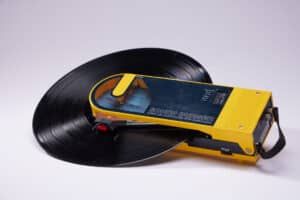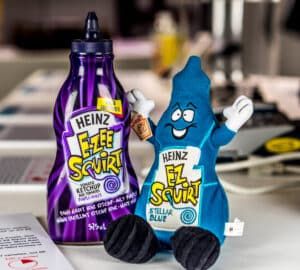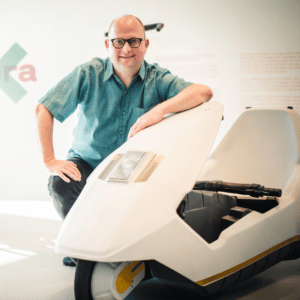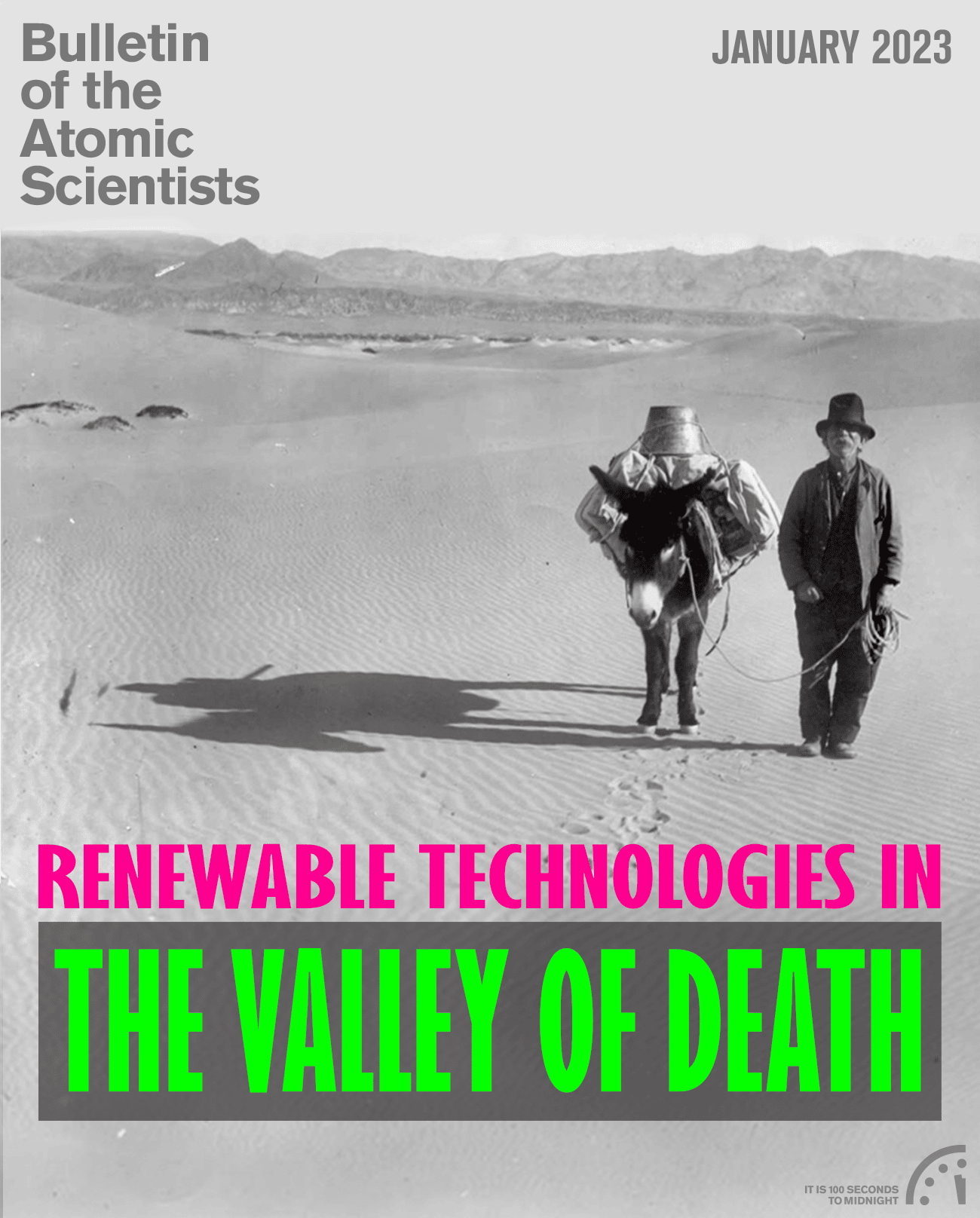Interview with Samuel West, founder of the Museum of Failure
By Dan Drollette Jr | January 16, 2023
Interview with Samuel West, founder of the Museum of Failure
By Dan Drollette Jr | January 16, 2023
Remember the Apple Newton? No? What about Alta Vista, Netscape, or MySpace? Some failed gadgets, software, and the people who created them weren’t shuffled aside to be forgotten. Instead, these first tries laid the groundwork for more fully-formed ideas, such as the Smartphone, Google, Internet Explorer, or Facebook. Cutting-edge products may die an embarrassing death, but they often also lay the groundwork for better, more well-timed ideas with features that allow them to flourish later on.
But before society can get to those big successes, it has to accept that most of our first attempts will fail—sometimes publicly, and spectacularly.
As a result, fear of failure is a big obstacle to innovation, says Samuel West, a psychologist who studies corporate behavior. To help us all accept the idea of embracing failure and then moving on, West launched an exhibit in Sweden in June 2017 that showcased botched products and ideas. The goal was to celebrate the role failure plays in innovation and progress. Now called “The Museum of Failure,” it caught on, in the form of a traveling exhibit that’s been making its way around the globe, staying three months in each place it visits. At the time of this interview, the road show was in Canada, with plans to be in New York City shortly.
Despite its success, however, museum founder and curator West’s own experiences have illustrated the idea of failure preceding success: He registered a domain name for the exhibit and later realized he had misspelled the word “museum.”
(This interview has been condensed and edited for brevity and clarity.)
Dan Drollette Jr: Thanks for agreeing to this Zoom interview. I understand you’re participating in this call from an art gallery in Sweden?
Samuel West: Yes, Stockholm.
Drollette: Small world. I remember going there for a conference for work, and then staying on afterward to explore the city. What really struck me was an exhibition dedicated to a 17th-century warship that sunk on its maiden voyage in Stockholm harbor, right in front of the king and a huge crowd of spectators, after sailing less than a mile. I thought it was fascinating; I wound up staying there all day long.
West: Right, the Vasa. It’s famous. And a big part of the story was that the ship lay untouched at the bottom of the harbor until the 1960s, when it was relocated, raised to the surface, and made into a history museum, where it acts as a sort of time capsule. People use it to explore life in the 1600s—and what went wrong that day.
Drollette: Sort of a natural segue to what you’re doing now.
West: The Vasa definitely qualifies as a candidate for the Museum of Failure.
Drollette: What exactly is the Museum of Failure?
West: The soundbite is that this museum is a collection of failed innovations from around the world.

Drollette: But you’re not really mocking them, are you?
West: No, not at all. The whole aim of the museum is to help people recognize that we need to accept failure if we want progress.
And by that I mean any kind of progress, not just consumer products and new devices. The main point is that we have to accept failure, because it usually takes several iterations before we get things right—most experiments fail.
And then the second point—which I try to make money off of, with varying degrees of success—is to emphasize that companies in particular have to be better at learning from their failures.
A corollary is that it is not cool just to “fail fast”—as they like to say in Silicon Valley. Or to “move fast and break things,” or any of those clichés. Yes, it’s okay to fail, but you have to learn something from the experience.
Those are the goals of the museum, anyway.

Drollette: So just trying and failing is one thing. But if you try, fail, and learn from it…
West: …then you pick up something useful, which is the goal. You fail but you gain insight, build on it, try a different version, tinker, and come back again with something better. That’s the sweet spot, right there.
Drollette: Why is that an important distinction?
West: There’s been a tendency lately, especially in Silicon Valley, to accept the whole motto of “failing forward.” Or “failing fast.” They’re very good at accepting failure there. But they’re not any better than anyone else at learning from failure, because they then make the same mistakes over and over again.
You want people to take meaningful risks and learn from them. That’s where the action is, when it comes to innovation: People trying something new, accepting the level of risk that comes with it, and learning from it if the new thing fails—as it probably will.
And the whole concept of taking on meaningful risk is tricky. It’s not something people do naturally in school or in science or in a corporate environment, regardless of whether it’s American culture, Swedish culture, organizational culture—people have to actively work to take them on.
But if you want innovation, you have to do something to get people to take those meaningful risks of failure. That’s where the magic happens, when it comes to innovation.
Drollette: How did you get interested in this area?
West: How long will your article be?
Drollette: Well, we want to give the topic adequate space but avoid doing War and Peace…
West: (Laughs.) Ok, I’ll give you the short version. I’m a clinical psychologist, who’s done a lot of work with corporations. And then I did a PhD later, on playfulness and creativity in the workplace—the idea being that you can harness the power of playful experimentation for organizational innovation.
And it was while working with clients and doing research that I realized that there’s no lack of methods or cool processes for innovation. The main obstacles are that people are afraid of failing, and being embarrassed by it—those are two of the biggest obstacles for innovation. This happens even in the world of science, which is supposedly a place where you can’t get criticized if you do something and the experiment fails—especially if you do it the way everyone else before you has done it. But if you do something a little bit different and you fail, then it’s: “You’re not gonna get any more funding, sir.”

Drollette: Since you brought up the topic of different countries and different cultures: Where are you originally from? What culture do you identify with?
West: I’m half American—California—and half Icelandic. So San Francisco and Reykjavik.
Drollette: Wow, those seem very different. Are there any things they have in common?
West: Well, there is a bit of a conformist streak to societies everywhere, no matter how they like to portray themselves.
I mean, in one way you could say that California—or Sweden—is all about individualism. But it’s still a kind of limited individualism, where you don’t want to break the unspoken rules. You can wear a colorful tie or drive a little funky car, that’s cute. But to have a lifestyle that doesn’t follow the cookie-cutter model is still a place where you have to struggle for acceptance.
Now, are these societies different as to how people relate to failure? It’s hard to say. On the one hand, there’s the attitude of “Go for it—and if you screw up, it’s okay, we’ll clean up the mess.” But at the same time there’s this competing urge to control every detail and and make sure that failure doesn’t happen in the first place. And hence, they’re not innovative.
Drollette: What else?
West: I think that for a lot of people in a lot of societies, there’s this feeling deep down that “I’m a fraud; I’m going to be exposed”—what’s called “Impostor Syndrome.”
I think this phenomenon is actually growing. Researchers don’t know if it’s a generational thing—that people entering or peaking in their careers right now feel more of it, but they certainly talk about it more.
Drollette: What exactly is it?
West: The idea that “Now I’ve got this nice job, with salary and position. And I don’t know what the hell I’m doing.”
It’s just crazy.
But it is indeed part of what is going in the background, in the mindset of those who are trying to come up with new technologies.
Drollette: Including renewable technologies?
West: Right. As you know, Biden did get a significant sum of money for renewable technology—something like $370 billion, when all is said and done, to find ways to combat climate change. And all that money means that there’s bound to be a lot of ideas that will come up—which is great, because there’s not likely to be one single golden solution; we need thousands of different solutions.
But most of these will, inevitably, fail.
In that regard, renewable technologies are no different from any other kind of innovation. The principles are the same: When you’re pushing the boundaries, then the risk of failure is extremely high.
We have to understand that if it was easy, we would have had the solutions a long time ago,
For a technology to be feasible as an alternative, it has to be of good quality and cheap and widely acceptable. There’s a lot of criteria to meet.
And there’s something else going on here as well. When a big corporation like Apple or Samsung messes up on a new phone, everybody just shrugs their shoulders. The attitude is: “Yeah, yeah, whatever—greedy capitalistic company, they make stuff and they screw up.” And so there’s not really much to discuss there.
But when governments, organizations, researchers, or charities are engaged in working on these non-commercial projects to help improve the world, then somehow people change their mindset. We hold do-gooders to a higher moral ground and expect more from them—including from the technology they produce.
Consequently, those engaged in the R&D face the temptation to do something that they know will work, rather than have to report back to their donors that “I screwed up.”

Drollette: So the bar is set higher when trying to do something good for the planet?
West: That, and the fact that it’s often other people’s money that they’re using—in this case, the American taxpayers’ money.
And this doesn’t just happen in the US. I’d say the same is true for every country that has funds set aside for new renewables technology, whether you call it an “innovation fund” or “green fund,” or whatever.
Which is sad because this higher bar acts to the detriment of the real risk-takers; they don’t get the funding. Instead, the money tends to go to the sure thing. It’s a mistake, because we need new ideas: Carbon-dioxide scrubbers are not the solution to everything.
Don’t get me wrong, that carbon dioxide removal technology—which has seen a lot of R&D in Iceland—is a great thing; it’s awesome. But at the same time, that technology is like a drop in the ocean when it comes to removing carbon from the atmosphere. It has about as much effect as you not taking your car to work for one day. It’s nothing.
And it’s not just the technology itself that has these hurdles to overcome. There’s the business model behind it, the user model, the application model of the tech—they each face the same hurdles. These aspects don’t get as much funding; they’re not as sexy as the latest, most fantastic gizmo for renewable energy. But they’re just as important: If nobody wants to use a technology, or it looks stupid, or makes a lot of noise, or is too complex, then it doesn’t matter how elegant the technology is—nobody’s gonna use it.
That’s a huge part of the products on display at the Museum of Failure—where the technology is awesome, but implementation is horrible.
Drollette: What’s a good example of something where the tech was okay, but the implementation failed?
West: In terms of branding—where there was a mismatch—there was the Harley-Davidson Barbie doll. Fat-free Pringles. Green ketchup. Colgate frozen lasagna.
But I think the best for what we’re talking about here is 2012’s Google Glass.

There was nothing wrong with the technology per se, it was super exciting. But the way they launched it, and the way they implemented the technology to users, screwed it all up.
Drollette: Is one your favorite?
West: I really can’t say which one I like most because it changes all the time. But now I’m kind of into ones that have weird backgrounds to them, like the Amstrad Emailer. It looks like a combination of computer, fax, and landline phone that you could use to send emails. And you had to pay per email. The only reason it exists is because it was the vision of the founder of the company, an eccentric British lord and respected British businessman, and he kept it alive.
And like a lot of the things that have failed, the Amstrad Emailier failed because the founder did not listen to the people around him. We often have this vision of the maverick pioneer who goes his own way, doesn’t listen to anyone else, and becomes mega-successful. But the reality is, that’s very rare.
Most times, if you don’t listen to the people around you—your customers, your staff, the employees, what have you—it’s probably going to go pretty bad.

Drollette: Is your idea about the Museum of Failure catching on? I saw where there’s now a thing called the Institute of Brilliant Failures in the Netherlands.
West: I know them, they’re cool. Oh yes, I mean, there’s a lot more people in this space, including groups such as FuckUp Nights.
Drollette: What is that about?
West: You should check them out. They organize, like TED Talks in the evenings. It gives people a forum to say “Well, this, I tried this and I tried that.” It’s interesting, for sure, and it’s spread all over the world. (Editor’s note: The organization’s mission statement says “Fuckup Nights is a global movement and series of events where stories of failure are shared. Each month, at events around the world, we get three or four people to face a room full of strangers to share their own fuckup. Stories of businesses that go bust, partner deals that fall out, products that have to be recalled, we tell it all.”)
Drollette: What do you have in mind for your next project?
West: Build another Vasa. (Laughs.)
I’m kind of playing with a lot of different ideas right now but I haven’t really committed to any of them. They’re more like non-commercial art exhibitions—such as a website that allows me to express my anger over how we’ve allowed large corporations to screw over the planet. While the oil companies are spewing out gigatons of carbon into the air, the rest of us are supposed to save the environment by buying paper straws instead of plastic. I mean come on, let’s get real.
Drollette: Any last comments?
West: I think that the idea of embracing failure has definitely met the zeitgeist. Had the Museum of Failure opened five years earlier, it probably wouldn’t have gotten that much attention. And I think that at some point, either people are going to get tired of the message from all these groups involved with failure and tell them to shut up—or we’ll actually get a fundamental change and decrease the stigma of taking meaningful risks and failing.
Drollette: In other words, efforts to destigmatize failure will succeed?
West: Well, yes. The aim is that by showcasing these failures, we can actually learn from them. And get people to accept them, and be less afraid of talking about failure.

Together, we make the world safer.
The Bulletin elevates expert voices above the noise. But as an independent nonprofit organization, our operations depend on the support of readers like you. Help us continue to deliver quality journalism that holds leaders accountable. Your support of our work at any level is important. In return, we promise our coverage will be understandable, influential, vigilant, solution-oriented, and fair-minded. Together we can make a difference.





















